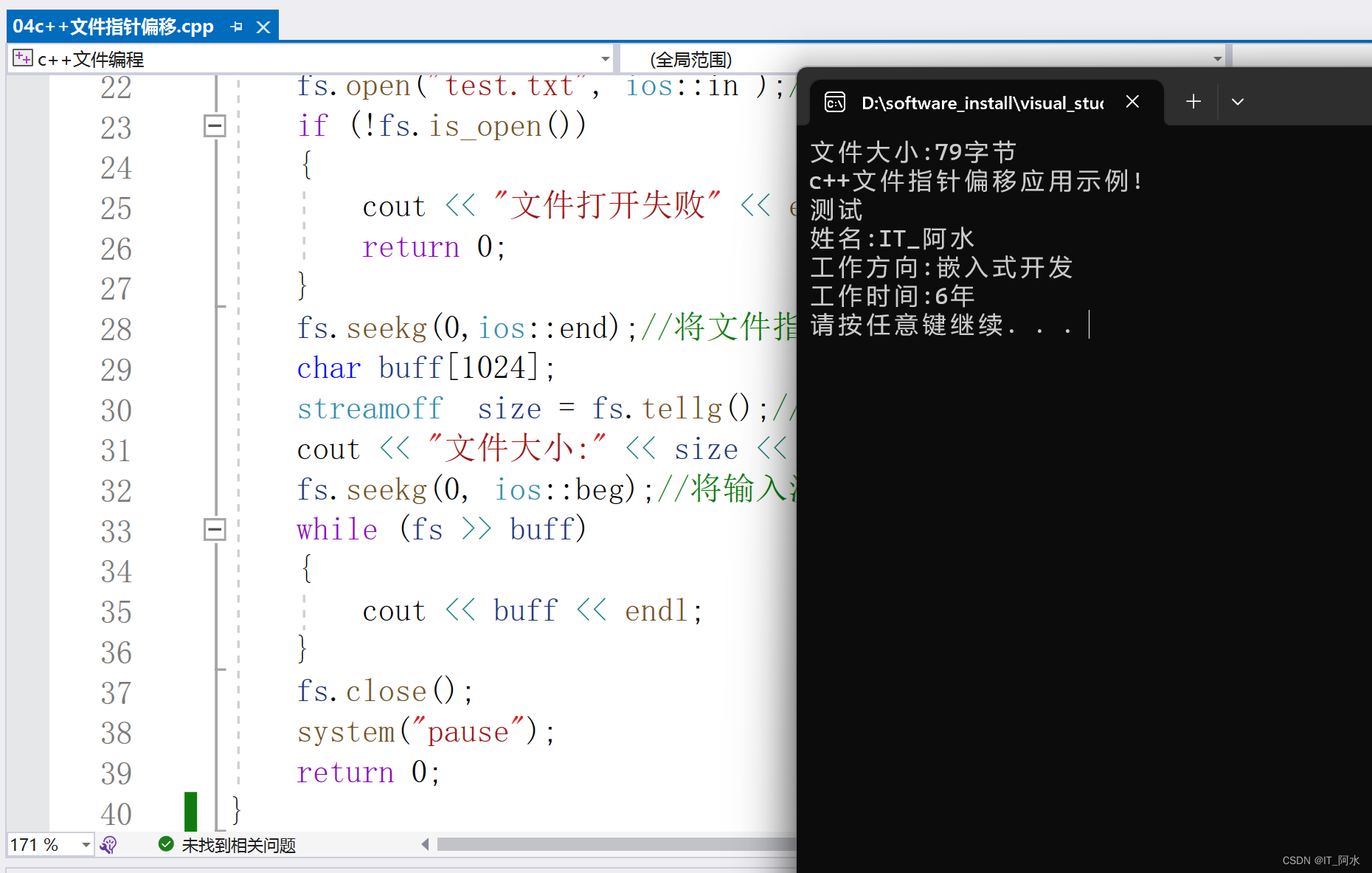1.C++文件操作
C++中文件操作头文件:fstream。
文件类型:文件文件和二进制文件。
- 文件操作三大类:
ofstream 写操作
ifstream 读操作
fstream:读写操作 - 文件打开方式:
| 标志 | 说明 |
|---|---|
| ios::in | 只读 |
| ios::out | 只写,文件不存在则创建,存在则打开并截断原内容 |
| ios::ate | 打开一个已有的文件,并指向文件读指针指向文件尾,若文件不存在,则打开出错 |
| ios::app | 打开文件,从文件尾添加内容,若文件不存在则创建 |
| ios::trunc | 打开文件同时会截断原内容,单独使用时与ios::out相同 |
| ios::binary | 以二进制方式打开 |
| ios::in|ios::out | 打开文件,可读也可写,文件打开时原内容保持不变,若不存在则打开出错 |
| ios::in|ios::out|ios::trunc | 打开文件,可读写,会截断原内容,文件不存在则创建 |
2.文本方式写入示例
#include < iostream >
#include < fstream >
using namespace std;
int main()
{
/*1.创建文件*/
ofstream fp;
fp.open("test.txt",ios::out);//创建文件,会截断原内容
if (!fp.is_open())//文件打开失败返回false
{
cout << "文件打开失败!" << endl;
return 0;
}
fp << "C++文件操作示例!" << endl;
fp << "写入数据测试" << endl;
fp << "姓名:IT_阿水" << "t工作方向:" << "嵌入式开发" << "t工作时间:" << "6年" << endl;
fp.close();//关闭文件
system("pause");
}
3.文本方式读取示例
C++中读取数据有多种方式实现。
2.1 示例1:重载>>读取
#include < iostream >
#include < fstream >
using namespace std;
int main()
{
ifstream ifs;
ifs.open("test.txt",ios::in);//只读方式打开
if (!ifs.is_open())
{
cout << "文件打开失败!" << endl;
return 0;
}
string str;
while (ifs >> str)//以字符串方式读取
{
cout << "str=" << str << endl;;
}
//关闭文件
ifs.close();
system("pause");
}
2.2 利用成员函数getline读取
#include < iostream >
#include < fstream >
using namespace std;
int main()
{
ifstream ifs;
ifs.open("test.txt",ios::in);//只读方式打开
if (!ifs.is_open())
{
cout << "文件打开失败!" << endl;
return 0;
}
//第二种:getline()
char buff[1024];
while (ifs.getline(buff, sizeof(buff)))
{
cout << "buff=" << buff << endl;
}
//关闭文件
ifs.close();
system("pause");
}
2.3 单个字符方式读取get()
#include < iostream >
#include < fstream >
using namespace std;
int main()
{
ifstream ifs;
ifs.open("test.txt",ios::in);//只读方式打开
if (!ifs.is_open())
{
cout << "文件打开失败!" << endl;
return 0;
}
//第三种:单个字符方式读取
char c;
while ((c = ifs.get()) != EOF)
{
cout << c;
}
//关闭文件
ifs.close();
system("pause");
}
4.二进制方式读写示例
- 二进制数据写入文件
函数:write(const _Elem* _Str, streamsize _Count)
形参:_Str --写入的内容的起始地址
_Count --写入的字节数
- 二进制数据读取文件
read(_Elem* _Str, streamsize _Count) ;
形参:_Str --读取内容存放缓冲区
_Count --要读取的字节数
#include < iostream >
#include < fstream >
#include < cstring >
using namespace std;
class Person
{
public:
Person() {
}
Person(const char* name, int age)
{
strcpy_s(this->name, name);
this->age = age;
}
char name[20];//姓名
int age;//年龄
};
int main()
{
/*二进制写入数据示例*/
fstream fs("test.doc", ios::out | ios::binary);
if (!fs.is_open())
{
cout << "文件创建失败" << endl;
return 0;
}
Person p("小王", 18);
fs.write((const char *) & p, sizeof(p));//写入内容
fs.close();//关闭文件
/*二进制读取数据示例*/
fs.open("test.doc", ios::in | ios::binary);
if (!fs.is_open())
{
cout << "文件打开失败" << endl;
return 0;
}
Person p2;
fs.read((char *) & p2, sizeof(p2));
cout << "读取的内容:" << endl;
cout << "姓名:" << p2.name < < "t年龄:" << p2.age << endl;
fs.close();
system("pause");
}
5.C++文件指针偏移
//C++文件指针偏移
seekg(pos_type _Pos,ios_base::seekdir _Way) --用于输入流,偏移位置指针到指定位置
seekp(pos_type _Pos,ios_base::seekdir _Way) --用于输出流,偏移位置指针到指定位置
第一个参数:偏移量
第二个参数:基于哪个位置
ios::beg --文件头
ios::end --文件尾
ios::cur --当前位置
streamoff tellg() --用于输入流,返回当前指针位置,streamoff 是一个long long类型
streamoff tellp() --用于输出流,返回当前指针位置
返回值返回基于文件头的偏移量,字节为单位。失败则返回-1
- 示例:
#include < iostream >
#include < fstream >
using namespace std;
int main()
{
ifstream fs;
fs.open("test.txt", ios::in );//打开文件,不存在则打开失败,不会截断原内容
if (!fs.is_open())
{
cout << "文件打开失败" << endl;
return 0;
}
fs.seekg(0,ios::end);//将文件指针偏移到文件末尾
char buff[1024];
streamoff size = fs.tellg();//获取文件大小
cout << "文件大小:" << size << "字节" << endl;
fs.seekg(0, ios::beg);//将输入流偏移到文件头
while (fs >> buff)
{
cout << buff << endl;
}
fs.close();
system("pause");
return 0;
}
